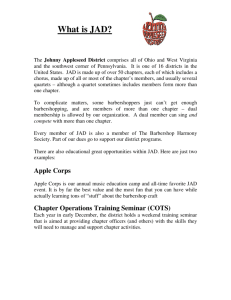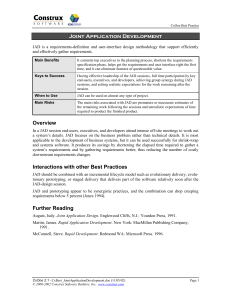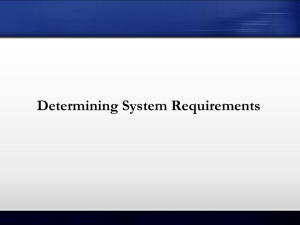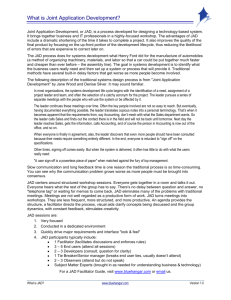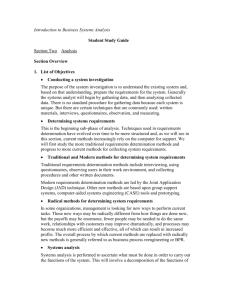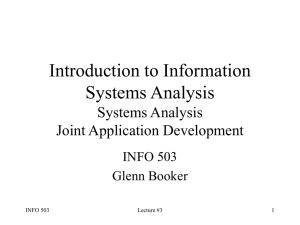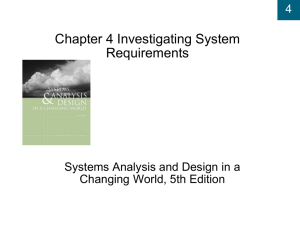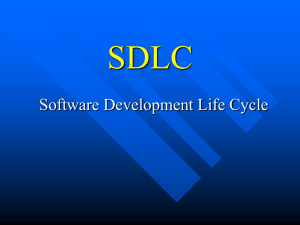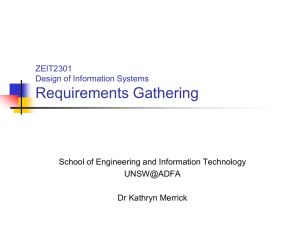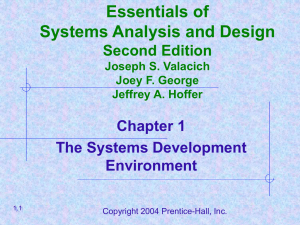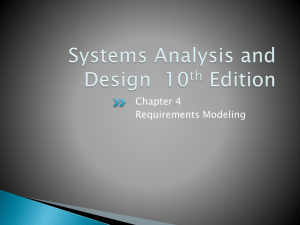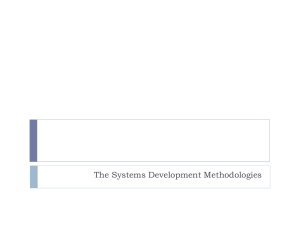Chapter 8 Determining System Requirements
advertisement
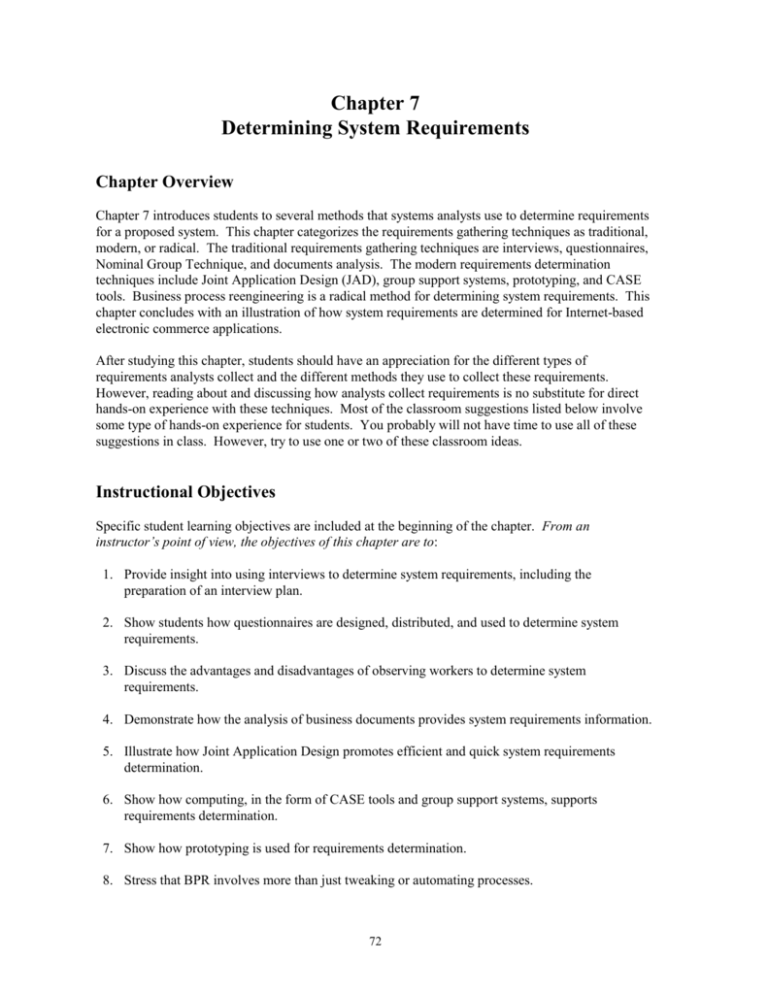
Chapter 7 Determining System Requirements Chapter Overview Chapter 7 introduces students to several methods that systems analysts use to determine requirements for a proposed system. This chapter categorizes the requirements gathering techniques as traditional, modern, or radical. The traditional requirements gathering techniques are interviews, questionnaires, Nominal Group Technique, and documents analysis. The modern requirements determination techniques include Joint Application Design (JAD), group support systems, prototyping, and CASE tools. Business process reengineering is a radical method for determining system requirements. This chapter concludes with an illustration of how system requirements are determined for Internet-based electronic commerce applications. After studying this chapter, students should have an appreciation for the different types of requirements analysts collect and the different methods they use to collect these requirements. However, reading about and discussing how analysts collect requirements is no substitute for direct hands-on experience with these techniques. Most of the classroom suggestions listed below involve some type of hands-on experience for students. You probably will not have time to use all of these suggestions in class. However, try to use one or two of these classroom ideas. Instructional Objectives Specific student learning objectives are included at the beginning of the chapter. From an instructor’s point of view, the objectives of this chapter are to: 1. Provide insight into using interviews to determine system requirements, including the preparation of an interview plan. 2. Show students how questionnaires are designed, distributed, and used to determine system requirements. 3. Discuss the advantages and disadvantages of observing workers to determine system requirements. 4. Demonstrate how the analysis of business documents provides system requirements information. 5. Illustrate how Joint Application Design promotes efficient and quick system requirements determination. 6. Show how computing, in the form of CASE tools and group support systems, supports requirements determination. 7. Show how prototyping is used for requirements determination. 8. Stress that BPR involves more than just tweaking or automating processes. 72 Chapter 7 Determining System Requirements 9. Illustrate how disruptive technologies enable the breaking of long-held business rules. 10. Discuss the system requirements determination process for Internet-based electronic commerce applications. Classroom Ideas 1. Point out that, while requirements determination tools and techniques are valuable in the analysis phase, analysts benefit from their use in other phases of the life cycle. Demonstrate this with examples from other phases. For example, JAD is useful in the early phases of design, such as where input and output formats are designed. Also, observation is useful during system implementation to verify that the new system is being used as expected. 2. Use Figure 7-2 to show how to construct an interview plan. Construct a plan with students during class and have them generate similar plans as homework. 3. Use Field Exercise 1 as an in-class exercise. This exercise typically takes about one hour to complete, including time for discussion of the results. Students can submit their reports at the next class meeting. 4. Illustrate in class the right and wrong ways to develop questionnaires. Discuss with students, using Table 7-4, the advantages and disadvantages of questionnaires compared to interviews. 5. Use the box “Lost Soft Drink Sales” as a starting point for a class discussion on the advantages and disadvantages of direct observation. You may want to expand the discussion of direct observation, especially if you have experience as an action researcher, since the methods are similar. You can discuss using confederates, how to avoid observer biases, and other issues you consider important. Often students are reluctant to use direct observation and should be encouraged to consider it equal to interviewing. 6. Figures 7-3, 7-4, and 7-5 can serve as the basis for a discussion of document analysis and how system requirements can be determined from documents. You or your students should bring sample documents, such as bills and order forms, to class for analysis. Demonstrate how you analyze these documents to discover business rules, as well as content requirements. For example, a shipping form shows whether the firm has ship to, order from, and bill to addresses. A class registration form may indicate the maximum length for student names. Save these forms, since they can also be used with Chapter 14 in discussing input, output, and user interface design. 7. The end-of-chapter references provide useful sources of information to supplement a class discussion about JAD. The Wood and Silver book is an especially good source. 8. Three of the four video segments that accompany this textbook can be used with Chapter 7. The most appropriate is the Joint Application Design video segment. This video segment is about 18 minutes long. Also very appropriate is the video segment called Managing Expectations, which is about 12 minutes long. A third video segment on Application Engineering is appropriate, if you have not used it with a prior chapter. Notes on using these video segments are included in a separate section of this instructor’s manual. See the Preface to this instructor’s manual for 73 Modern Systems Analysis and Design, 3rd edition Instructor’s Manual information on how to obtain the video segments produced for use with the third edition of Modern Systems Analysis and Design. 9. Using a business case, run a mock JAD in class, and assign students roles as analysts, managers, and users. As with a real JAD, the person chosen as facilitator is crucial to the exercise’s success. The mock JAD should be preceded by the type of careful planning that precedes actual JADs, as outlined in the text. 10. Use a CASE tool to support the mock JAD outlined in Classroom Idea #9. 11. Use a group support system to support the mock JAD outlined in Classroom Idea #9. The planning necessary for the JAD should be supplemented with the planning necessary for GSS use. 12. Conduct a prototyping session in class, using a 4GL, prototyping tool, or CASE tool with a prototyping component. If such software is available to your students, have them create prototypes based on system requirements found in a business case or in materials you provide. 13. Take an activity with which students are familiar, such as enrollment. Have your students reengineer this activity. Encourage students to be innovative. 14. Have students identify an organization that would benefit from an Internet-based electronic commerce application. Place your students into groups of three or four individuals. Then, have the students determine the system requirements for the Internet-based electronic commerce application. Answers to Key Terms Suggested answers are provided below. These answers are presented top-down, left to right. 2. 3. 8. 7. 4. Closed-ended questions Disruptive technologies Nominal Group Technique Key business processes Formal system 1. 5. 10. 9. 6. Business process reengineering Informal system Scribe Open-ended systems JAD session leader Answers to Review Questions 1. During systems analysis, determine how the current information system functions and assess what users would like to see in a new system. Requirements determination, requirements structuring, and alternative generation and selection are the three primary systems analysis activities. 2. Traditional techniques for collecting requirements include interviewing and listening, administering questionnaires, observing users, and document and procedure analysis. Interviewing and listening involves speaking with users individually or as a group to discover 74 Chapter 7 Determining System Requirements their views about the current and target systems; it also involves carefully preparing an interview outline and guide before conducting the interview. Interviews are best done when only a few people are involved, when you use open-ended questions or the questions vary from individual to individual, or when a more personal method is needed. Administering questionnaires involves designing a questionnaire and determining who should respond to it; this method is typically used when there are too many key users to interview individually. Questionnaires are best when many people are involved, each person is to answer roughly the same questions, and people are remote or do not need personal care. Directly observing users involves watching how people work in order to uncover information. Direct observation is best when detailed or complicated procedures must be documented, when you do not want people to know they are giving you information you need, when only a few people are involved, and observational data are representative of all situations. Analyzing procedures and other documents involves identifying and collecting written procedures, forms, reports, and other relevant documents in order to better identify data and processes that would be part of the current and target systems. Analyzing documents is the best technique when documents are complete and unbiased, when other forms of requirements determination are too obtrusive, and when history must be studied and people do not have firsthand data about history. 3. Interviews provide large amounts of rich, detailed information, but they are expensive to conduct in terms of the time they demand. Questionnaires, on the other hand, can reach many people at once, making them relatively less costly than interviews, but the collected data is not as rich or as plentiful as is the case with interviews. Both techniques involve careful planning and execution to be successful. Deciding which technique to use depends on several factors, such as the size and complexity of the information system under study, the size and complexity of the organization in which the system resides, available funding, and the expertise and preferences of the analysts. 4. Joint Application Design (JAD) is a structured process in which users, managers, and analysts work together for several days in a series of intensive meetings to specify or review system requirements. JAD is better than traditional techniques because you have all key personnel in one place at one time, saving everyone time and resulting in high levels of system ownership as more people have more of a role in the development process. Weaknesses include the level of commitment necessary to make the JAD work, the high degree of required planning, and the typical lack of computer support. 5. Computing supports requirements determination in the form of CASE tools, group support systems, and prototyping. 6. The Nominal Group Technique is a facilitated process that supports idea generation by groups. NGT encourages individuals to identify and prioritize problems with an existing system or requirements for a new system. 7. CASE tools can support requirements determination by supporting JAD and prototyping with diagramming, form and report design, repository access, and prototyping tools. The best-suited CASE tools are upper CASE tools. 8. During requirements determination, prototyping is used to collect user requirements and present them in the form of a working system prototype. Users can look at, play with, and compare the prototype to their system requirements. Analysts can then adjust the prototype to better fit what the users have in mind. Prototyping is better than traditional methods where system 75 Modern Systems Analysis and Design, 3rd edition Instructor’s Manual requirements are not well understood, where few users that are stakeholders are involved, where designs may be complex, where there have been past communication problems, and where the necessary tools are readily available. Prototyping may be worse than traditional methods where formal requirements are not documented, where prototypes become idiosyncratic to the initial user, where issues of data sharing and integration with other systems are ignored, and where SDLC checks are bypassed. 9. Group support systems provide unique benefits for group requirements determination by providing everyone the opportunity for equal participation through typing instead of talking, and anonymity allows the shy and those afraid of criticism to participate. 10. As part of the BPR effort, key business processes should be identified. Key business processes are the structured, measured set of activities designed to produce a specific output for a particular customer or market. Once these key business processes have been identified, activities that can be radically improved should be identified. Primary candidates include activities that are viewed as important, changeable, or dysfunctional. BPR benefits include radical improvements in speed, quality, and customer satisfaction. 11. Disruptive technologies enable the breaking of long-held business rules that inhibit organizations from making radical business changes. Disruptive technologies enable companies to innovatively apply information technology. As a point of discussion, ask students to discuss the concept of a virtual university. Is this an acceptable application of disruptive technology? Answers to Problems and Exercises 1. Numerous articles are available in the library and on the Web. CASE tools are useful in JAD sessions because the JAD team can use the CASE tools (i.e., creating data flow diagrams, entity relationship diagrams, and a data dictionary) together. This helps the team to better, and more quickly, develop the system. A GSS is useful in JAD sessions because more team members can participate, the GSS can help keep the team on track, the team members can use the electronic, anonymous brainstorming tools, and the GSS automatically and accurately captures the outputs of the sessions. Some of the limits to using CASE and GSS in JAD are the availability of the tools, the learning curve for these tools if the team members are not familiar with them, and potentially over-structuring the development process. 2. Using a confederate or by hidden camera, the analyst can conduct observations unobtrusively, so the effect on the users’ behavior is minimized. The analyst can also brief the users on the observation so that the users will relax and behave naturally. For example, you can make it clear to users that they are not being evaluated and that the observations collected will not be associated with anyone individually. In addition, the analysts can perform multiple observations over time. This tends to minimize the effects of aberrant behaviors. Alternatively, the analysts can supplement their requirements determination with additional data collection methods. 3. One of the primary problems with analyzing business documents is that these documents do not provide a full picture of how work is done and why. First, business documents are often incomplete, since people have selectively retained documentation. Second, business documents often describe the formal system as opposed to the informal system, which is more often the way the work is actually completed. Whether the business documents are accurate or not, they provide useful information. If the business documents are accurate, then much of the work of 76 Chapter 7 Determining System Requirements gathering information requirements is nearly finished. If the business documents are inaccurate, then the analyst can use the documents to understand how the work processes ought to be done, or are thought to be done, or, perhaps, should not be done. In any event, analyzing business documents should be done in conjunction with other, supplemental data collection methods. In addition, the analyst should speak to multiple people to gather their perceptions and uses of the documents. 4. Students might suggest the following for the JAD leader: the JAD sessions should be off-site, the proper people should be invited to the JAD sessions, establish clear ground rules for the sessions, set and follow a clear agenda, distribute the agenda to all participants before the sessions, remain neutral on issues, make sure that everyone has the opportunity to participate, encourage people to be creative and break free of traditional ways of doing things, manage time effectively, and follow up with meeting notes. 5. The meeting’s objective is to determine which courses are required to develop necessary programmer/analyst skills. The agenda might include introductions, background, discussion of the courses already taken, discussion of course requirements not yet met, discussion of additional courses to take for preparation, plotting course schedules for successive semesters, summary of major points, questions from advisor, and closing. A meeting like this can last anywhere from 30 to 60 minutes, depending on the level of familiarity that the advisor has with the student’s case. 6. Three possible closed-ended questions, each in a different style, are: 1. Which of the following is the best feature about the word processor that you currently use to do your job (pick only one): a. good help system b. extra tools such as spell check, grammar check, thesaurus, and auto correct c. compatibility with other applications such as graphics package and spreadsheet 2. Please rank the following three items in terms of their need for improvement in the next version of this word processor. Place a “1” by the item which is most in need of improvement. ___ ease of use ___ speed ___ compatibility 3. The next version of this word processor should enable you to create and use hypertext markup language documents for use on the World Wide Web. 1 2 3 4 5 6 7 Strongly Agree Agree Agree Somewhat Neutral Disagree Somewhat Disagree Strongly Disagree 7. One way is to ask open-ended questions, allowing the individual to write whatever is on her mind. The questionnaire is more probing than if it had only closed-ended questions. Another method is to ask a multiple choice question or a yes/no question, and then, depending on which answer the respondent chooses, have her branch off into a specified set of questions. 77 Modern Systems Analysis and Design, 3rd edition Instructor’s Manual Alternatively, you might create different versions of a survey instrument, for example, one for users and one for managers. 8. Because the group interview might be more difficult to conduct and more time consuming, the analyst might add to the interview guide time certain events or time stamped agenda items. For example, if the meeting begins at 8:00 a.m., and the manager of the users will come in to the meeting to give a brief talk, this event might be scheduled for 8:15 a.m. until 8:30 a.m. Other processes in the meeting will be postponed during this event. With time stamping, the analyst writes definitive start times next to each of the agenda items and then uses this to keep the group on track. Alternatively, the analyst might write specific questions that should be asked of specific members of the interview group. If several analysts are involved in the group interview, the group could be broken into parallel sessions, each with its own agenda. Finally, agenda activities should be allotted for discussion and interchange between the interviewees, so that consensus and synergy can occur. 9. Some of the problems include scheduling difficulty, participation of all group members during the meeting, individuals afraid or unwilling to speak in front of other people, conflicts among group members, keeping the group on track, and accurately collecting all the information when multiple people speak at once. Ways to deal with these problems include providing training in team building, group dynamics, and managing conflict; having multiple interviewers work together; and using a technological aid such as CASE or GSS. 10. The answer to this question is facilitated by revisiting the definitions for corporate strategic planning and information systems planning. Corporate strategic planning is an ongoing process that defines the mission, objectives, and strategies of an organization. Information systems planning is an orderly means of assessing the information needs of an organization and defining the systems, databases, and technologies that will best satisfy those needs. The key to understanding BPR is that it is the search for and implementation of radical change in key business processes. Those organizations involved with BPR are looking for new, innovative ways to perform these processes. Guidelines for Using the Field Exercises 1. This exercise can take a class period, but it is very useful. This exercise simulates actual interviewing and gives the students much needed interview practice, comparison, and feedback. Allow sufficient time for discussion, or alternatively, have students write a short paper on their observations (as mentioned at the end of the exercise). 2. This is a useful method for learning about the team’s work processes. Students should identify and apply the comparative advantages and disadvantages of group interviews as discussed in the chapter. Student observations may vary based on group size, group history, and whether the group leader is present. 3. If the chosen teams closely follow the prescribed work method, then the information from the interview should match the information from the written documentation. If, however, some of the chosen teams use a more informal system for completing work, then the information from the interview is not likely to match the information from the written documentation. Ask your students to compare their answers and discuss why, and with what implications, these differences might exist. 78 Chapter 7 Determining System Requirements 4. JAD is becoming a popular development method, so the students should find systems professionals who have used JAD. The feedback should mirror the information on JAD presented in this chapter, and it will be useful for the students to have the textbook information confirmed by systems professionals in the “real world.” If the systems professionals provide additional information not covered in the textbook, share this information with the other students. It is likely that the group leader’s skills will be critical in the students’ assessment of the JAD experience. 5. Several JAD references are provided in the reference section of this chapter. For more recent publications on JAD, students will find articles in IS journals in the academic literature, IS magazines in the popular press, and on the Web. In addition, the proceedings of the annual International Conference on Information Systems and the Hawaii International Conference on Systems Sciences frequently have articles on JAD. 6. Students will discover that the organization’s systems were not merely tweaked; they were significantly modified to the betterment of the organization. If students cannot find a contact person, a visit to the library or to the Web will yield results. Also, you should encourage your students to identify companies that have undergone BPR, such as Ford. Ask the students to identify the tangible and intangible benefits of this process. Students should identify the costs as well. Guidelines for Using the Broadway Entertainment Company Cases Guidelines and answers for using the Broadway Entertainment Company cases are available on this textbook’s companion Web site. Please visit www.prenhall.com/hoffer to access this information. 79
